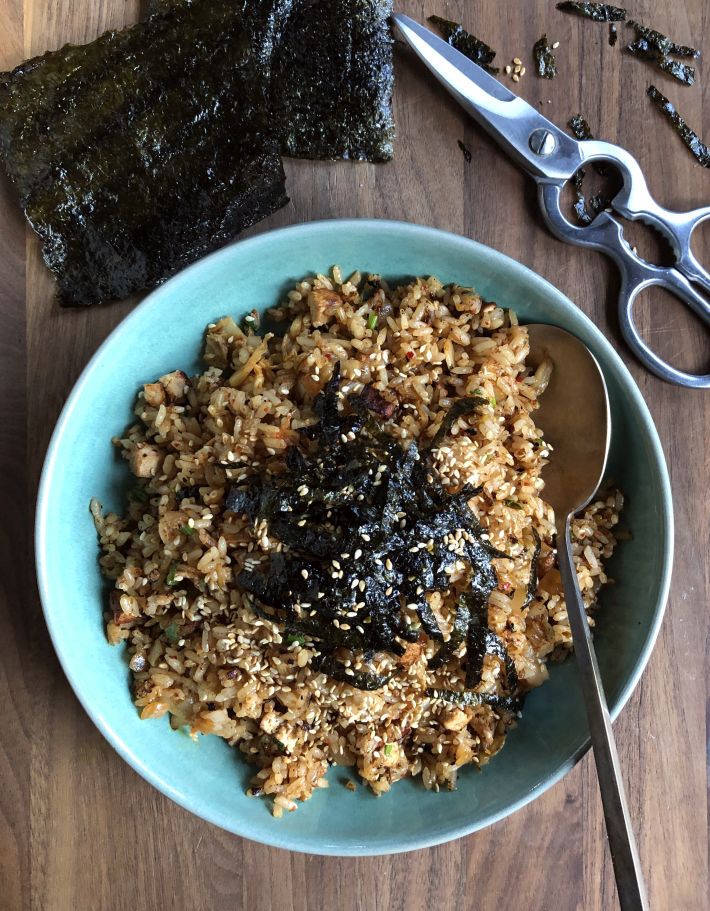
It’s a new year and perhaps a new you who wants to eat more vegetable-centric food. Okay, maybe I’m speaking for myself, but no matter what your new year resolutions are, this kimchi fried rice recipe will appeal. It’s also easy to make and versatile.
My take on Korean kimchi fried rice (kimchi-bokkeum-bap) gets bold flavors from aged funky kimchi, kimchi juice, and Korean pepper paste. There’s depth from well sauteed onion and richness from sesame oil. Toasted seaweed weaves umami into the rice. A little tofu offers protein and textural contrast.
I shared this rice with our neighbors who adored it. But they also saved a fair amount for their vegan son. A few pointers are below to guide you on your kimchi fried rice adventure.
Fry Dryish Rice
To encourage separate grains (an ideal for fried rice), cook rice with a touch less water than usual. Once it’s cooked, spread it out on a baking sheet. You can use leftover refrigerated rice too, so long as it’s not gummy. Cold takeout rice is actually rather nice as well; its grains fall apart nicely.
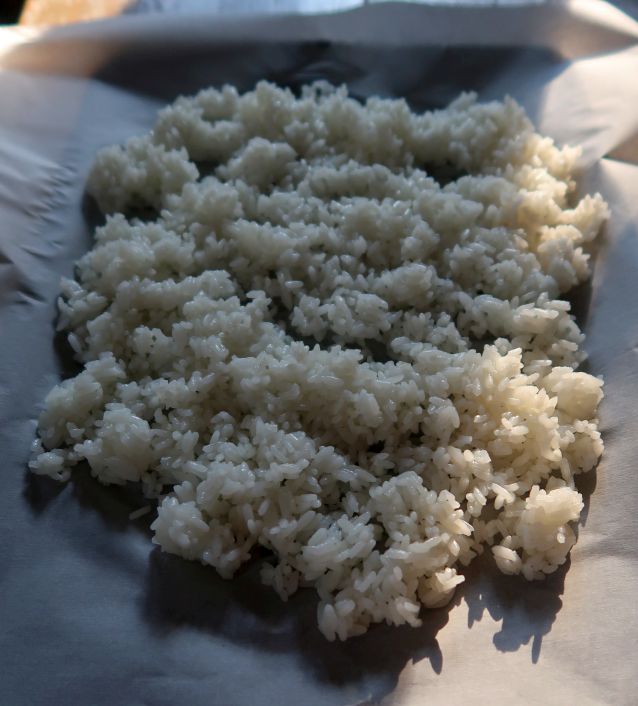
I cooked medium-grain Koda Farms Kokuho Rose rice for this recipe. You can use a short-grain rice like this one, too. If you have a favorite Korean rice, go for it! Regardless of rice type, make 1 cup of raw medium or short-grain rice to get the 3 cups needed for a batch of kimchi fried rice.
Stinky Kimchi Matters
Whenever I prepare kimchi-filled dumplings or fried rice -- where the kimchi serves as a seasoning as much as the main star, I use aged, strong tasting kimchi. This package of Sinto Gourmet kimchi, made in San Francisco and sold at Whole Foods, was in the back of my fridge for 2 or 3 months. It had a depth of flavor that was perfect for kimchi fried rice.
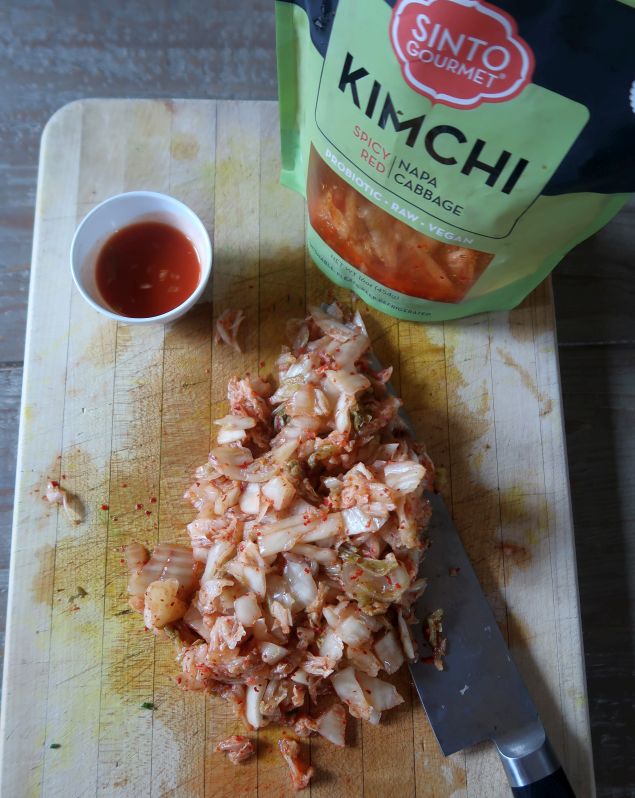
Don’t discount or discard it the kimchi juice! It's a key seasoning in this fried rice recipe.
If you’re a strict vegetarian, check the kimchi label to make sure there’s no seafood involved.
Finding Gochujang, Korean Red Pepper Paste
You can source gochujang, a Korean pantry item at Korean markets like H Mart. However, it’s also sold at well-stocked mainstream supermarkets. Just check the Asian ingredients section. Mother-in-Law’s is a New York-based brand sold at many health food and specialty markets.
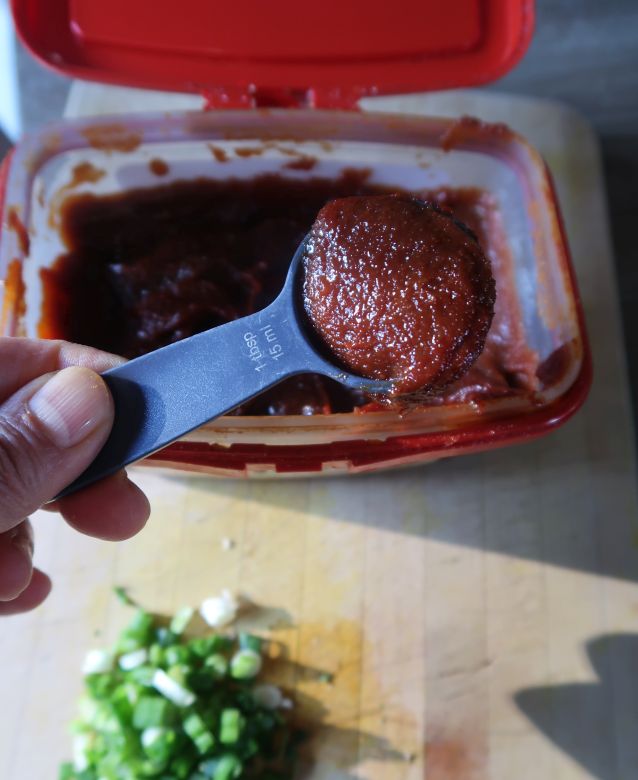
Look for Korean toasted seaweed (jim) nearby. If it’s not available, see the recipe Note for a quick DIY approach.
Stored in the fridge, gochujang keeps its fermented, winy heat indefinitely. I have some homemade stuff that’s maybe 8 years old.
Use a Big Skillet
I typically use a wok or large skillet for fried rice to make sure the heat conducts evenly and fast for fried rice. However, since kimchi is wet and you add a fair amount of liquid to the pan, I used the largest skillet I have. That meant a 14 inch-wide carbon steel pan that functioned practically like a hot griddle. (I have a Mauviel skillet but a DeBuyer with a helper handle is great, if you have space for it.)
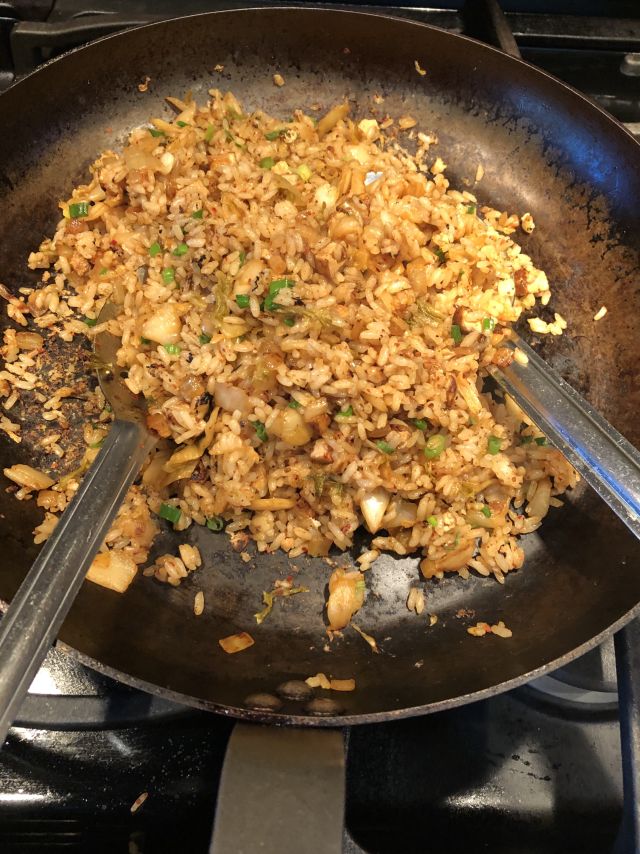
The pan’s wide surface created some rustic crustiness in the rice, which I like. And I can use two big metal spoons to efficiently move ingredients around.
Whatever pan you choose, apply big heat to move the fried rice action along. You’ll get exceptional flavor instead of a gummy mess. Fried rice is easygoing cooking that's perfect anytime.
Related recipes
- Joyce Chen’s Golden Egg Fried Rice
- Tofu, Kimchi and Bacon Tacos
- Wheat berries, Kimchi and Kale
- Korean Shrimp Dumplings
Kimchi Fried Rice
Ingredients
- 3 cups dry cooked rice, white medium or short-grain preferred, at room temperature
- 2 teaspoons sesame seeds optional
- 2 tablespoon neutral oil, such as canola oil
- 1 garlic clove, minced
- ½ medium red or yellow onion, chopped (¾ cup)
- ⅓ to ½ cup cubed extra-firm tofu (pan-fry as thick slabs before cutting, if you like)
- Fine sea salt
- 1 cup packed napa cabbage kimchi, chopped, older/stinkier kimchi preferred
- 1 tablespoon Korean red pepper paste (gochujang)
- 2 tablespoons kimchi juice
- 2 slender green onions, green and white parts, cut into thick rings
- 1 tablespoon sesame oil
- 3 or 4 pieces of Korean toasted seaweed (jim), snipped with scissors into narrow strips (optional)
Instructions
- If the rice is dry and lumpy, crumble it to prevent lumps. Set aside by the stove.
- Over medium heat in a large nonstick or well-seasoned skillet, toast the sesame seeds for 2 to 3 minutes, stirring often, until golden. Transfer to a small dish and keep by the rice. Line up the other ingredients in order of use so you can work fast.
- Add the oil to the pan, then heat over medium-high. Add the garlic and onion and cook, stirring for about 3 minutes, until fragrant and beginning to turn golden. Dump in the tofu and season with salt. Cook for about 1 minute to heat through.
- Add the kimchi, kimchi juice and gochujang, and stir-fry for 1 to 2 minutes, until heated through and very fragrant. There should be no liquid visible.
- Dump in the rice. Stir-fry for 1 to 2 minutes, to separate the grains and turn the rice a handsome orange-ish color. Season with salt to taste (I use ¼ to ½ teaspoon).
- Add the green onions and stir-fry for 15 seconds, until just wilted. Turn off heat and stir in sesame oil and half of the sesame seeds. Transfer to a shallow bowl, then top with the seaweed strips and remaining sesame seeds. Serve immediately.













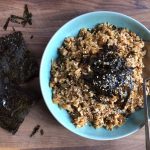




Merry Pearson says
Thanks bunch for this recipe. I have been in self isolation far away from home as my son and I cannot travel on account of his SLE. This site has been the guide I so much needed. Cooking rice is such a combination of art and science. Thanks a milly.
I sometimes see chefs sprinkling salt and olive oil especially when preparing separate rice, whats your take on this?
And would you get the same results if you used short or medium grain variety in place of long grain?
Andrea Nguyen says
In the main, when cooking plain rice, Asian cooks do not salt the rice or add oi. It's not a pasta, and the other dishes are expected to season the rice. The rice is integral to the dish. It's not a side dish.
Yes, to using short or medium grain rice. It would be great in this recipe.